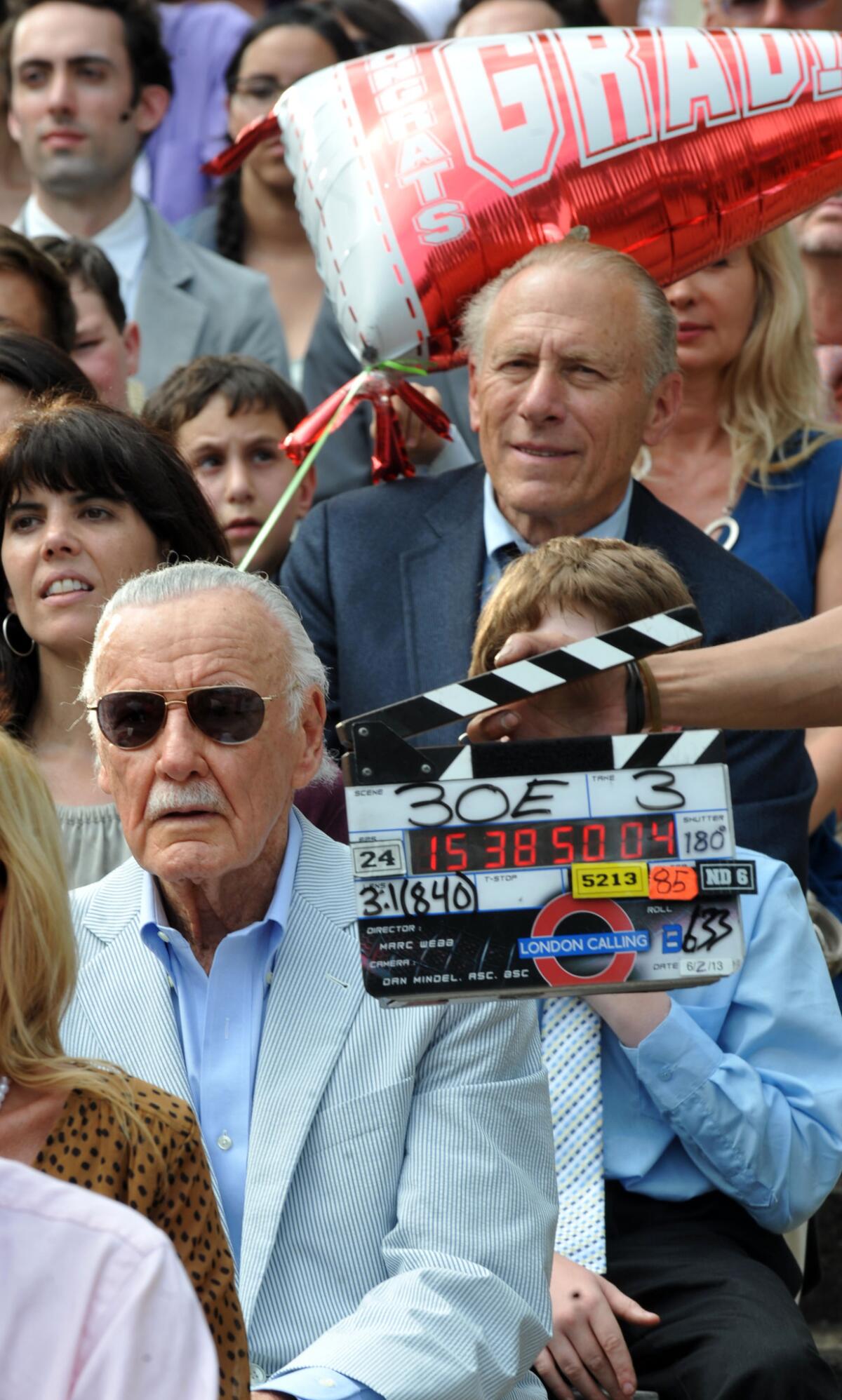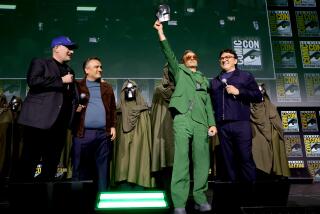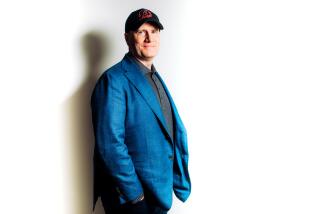The popularity of the Stan Lee cameo proved everything the Marvel Universe stands for
Everything that Stan Lee did was super-sized.
Where other writers created worlds, he created a universe populated by heroes blessed, or cursed, with special powers. Their conflicts, internal and external, played out across skylines and time warps, rearranged cities, destroyed planets. Their success created franchises available on multiple platforms, everything aimed at becoming more eyeball-battering, eardrum-splattering, boundary-breaking than whatever came before.
Everything, that is, except the cameo.
Beginning with âX-Menâ in 2000, Lee made appearances in each Marvel movie, playing everything from a Hugh Hefner look-alike (âIron Manâ) to a guy whose car gets shrunk in the superpower melee (âAnt-Man and the Wasp.â) He usually has a line, and it is almost always funny (âSuperheroes in New York?â he says, looking up from an outdoor chess game in âThe Avengers.â âGive me a break.â)

Even those members of the audience too young to remember a time when Lee was just a signature on a comic book, or what comic books meant once upon a time, looked forward to those moments. They were the biggest superpower reveal of them all. In the midst of chaotic extravagance, his appearance offered a momentâs reality check, breaking the fourth wall to remind us that while Chris Hemsworth may indeed be a god, it was this crazy old coot in the tinted aviators who started it all.
Imagine. The man in the grandad windbreaker, master of the universe.
That, after all, is the point of the Marvel Universe â great power can be bestowed on the most unlikely individuals, often with very mixed results. Lee himself dealt in mixed results. The credits battle between himself and illustrators Jack Kirby and Steve Ditko over iconic characters including the Fantastic Four and Spider-Man rages to this day (and requires a far more qualified scholar than myself to explain).
RELATED: An illustrated tribute to Stan Lee and his career Âť
Leeâs career and financial status rose and fell with the comic-book industry until the film franchise that began with âIron Manâ made him a star again. But his final years were marked by accusations that he had both abused his own power and been abused by those around him.
Every story in Leeâs universe was a contemplation of power: How it is acquired (accidentally, intentionally, with malice, in service), can it be controlled (yes, but almost always imperfectly), and, most important, what is the toll of such weighty imbalance (on the powerful and the meek).
Leeâs and later othersâ Marvel characters are, with a few notable exceptions, recognizable people (the quiet kid, the dashing arms scion, the sudden orphan, the devoted scientist) who become unrecognizable in their ability to lift cars/become invisible/swing from buildings/never die. They are united in the fact that their lives are never again their own.
âWith great power comes great responsibility,â is a line that could easily have come from Homer or Queen Elizabeth I or John Adams; instead it is the motto of Spider-Man, nee Peter Parker, and forms the narrative spine of all Leeâs work and its descendants.
First person: Stan Leeâs âX-Menâ made it OK â heroic, even â to be different Âť
What do those with superpowers owe those without? Constant protection from evildoers, obviously, but also the ongoing awareness that superpowers corrupt in a super-sized way. Constant vigilance is required and like most vigils, it is usually a lonely one.
Superheroes are fun because their powers are physical; they remain meaningful because their powers are metaphorical. In Stanâs Soapbox, a newsletter that pre-dated the direct communication between creator and audience via social media by several decades, Lee often reminded his audience of that; he reissued his 1968 declaration against racism after the attacks in Charlottesville, Va.
For all their CG glory, Spider-Man, the Avengers, the X-Men are there to remind us that power is not evenly distributed in this world and sometimes it is the most unlikely individual who stands in the way of evil, sometimes alone and heartsick, sometimes with a gang that includes a trash-talking raccoon.
And always, for a moment anyway, a skinny old guy with big glasses and one great line.

A look back at what fans and fellow comic book writers had to say about what Stan Lee means to them.
Hereâs a list of prominent Marvel movie cameos where Leeâs trademark aviator sunglasses showed up on screen.
âVenom,â 2018 - Dapper Dog Walker
âAnt-Man and the Wasp,â 2018 - Shrinking Car Owner
âAvengers: Infinity War,â 2018 - Bus Driver
âBlack Panther,â 2018 - Thirsty Gambler
âThor: Ragnarok,â 2017 - Barber (uncredited)
âSpider-Man: Homecoming,â 2017 - Gary
âGuardians of the Galaxy Vol. 2,â 2017 - Watcher Informant
âDoctor Strange,â 2016 - Bus Passenger
âX-Men: Apocalypse,â 2016 - Stan Lee
âCaptain America: Civil War,â 2016 - FedEx Driver
âDeadpool,â 2016 - Strip Club DJ
âAnt-Man,â 2015 - Bartender
âAvengers: Age of Ultron,â 2015 - Stan Lee
âGuardians of the Galaxy,â 2014 - Xandarian Ladiesâ Man
âThe Amazing Spider-Man 2,â 2014 - Graduation Guest
âCaptain America: The Winter Soldier,â 2014 - Smithsonian Guard
âThor: The Dark World,â 2013 - Stan Lee
âIron Man 3,â 2013 - Pageant Judge
âThe Amazing Spider-Man,â 2012 - School Librarian
âThe Avengers,â 2012 - Stan Lee
âCaptain America: The First Avenger,â 2011 - General (uncredited)
âThor,â 2011 - Stan the Man
âIron Man 2,â 2010 - Stan Lee
âThe Incredible Hulk,â 2008 - Milwaukee Man Drinking From Bottle (uncredited)
âIron Man,â 2008 - Stan Lee
âFantastic 4: Rise of the Silver Surfer,â 2007 - Stan Lee - Rejected Wedding Guest
âSpider-Man 3,â 2007 - Man in Times Square
âX-Men: The Last Stand,â 2006 - Waterhose Man
âFantastic Four,â 2005 - Willie Lumpkin
âSpider-Man 2,â 2004 - Man Dodging Debris
âHulk,â 2003 - Security Guard
âDaredevil,â 2003 - Old Man at Crossing
âSpider-Man,â 2002 - Man in Fair (uncredited)
âX-Men,â 2000 - Hot Dog Vendor
More to Read
Only good movies
Get the Indie Focus newsletter, Mark Olsen's weekly guide to the world of cinema.
You may occasionally receive promotional content from the Los Angeles Times.











